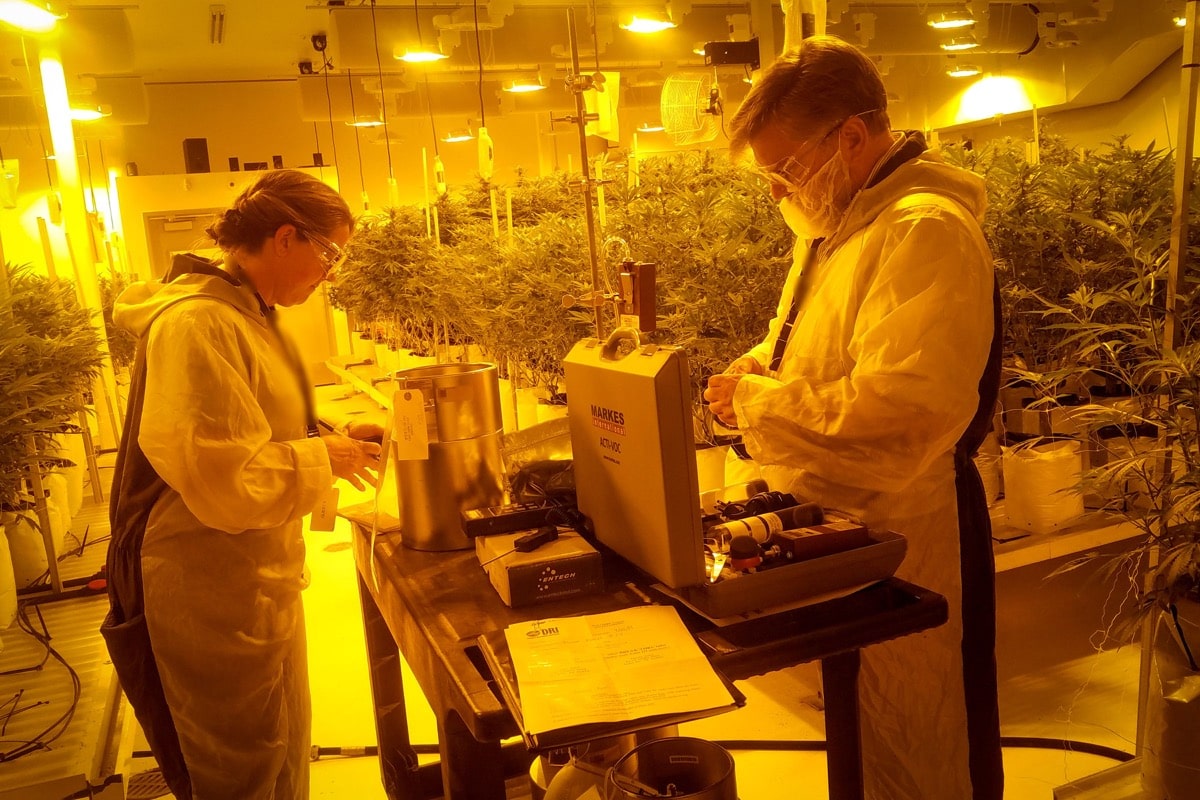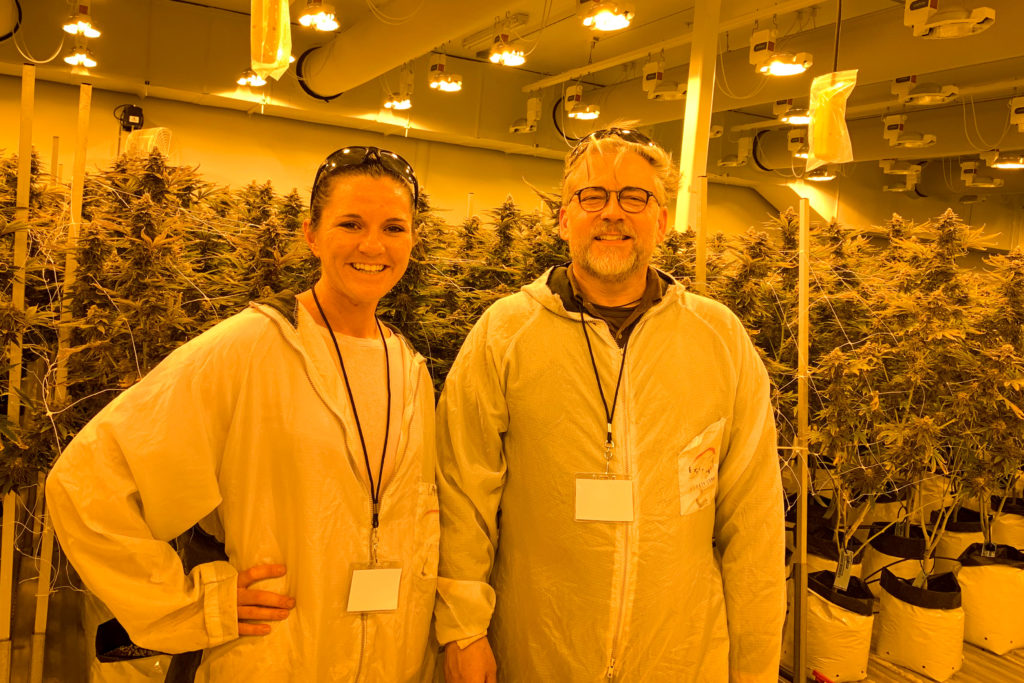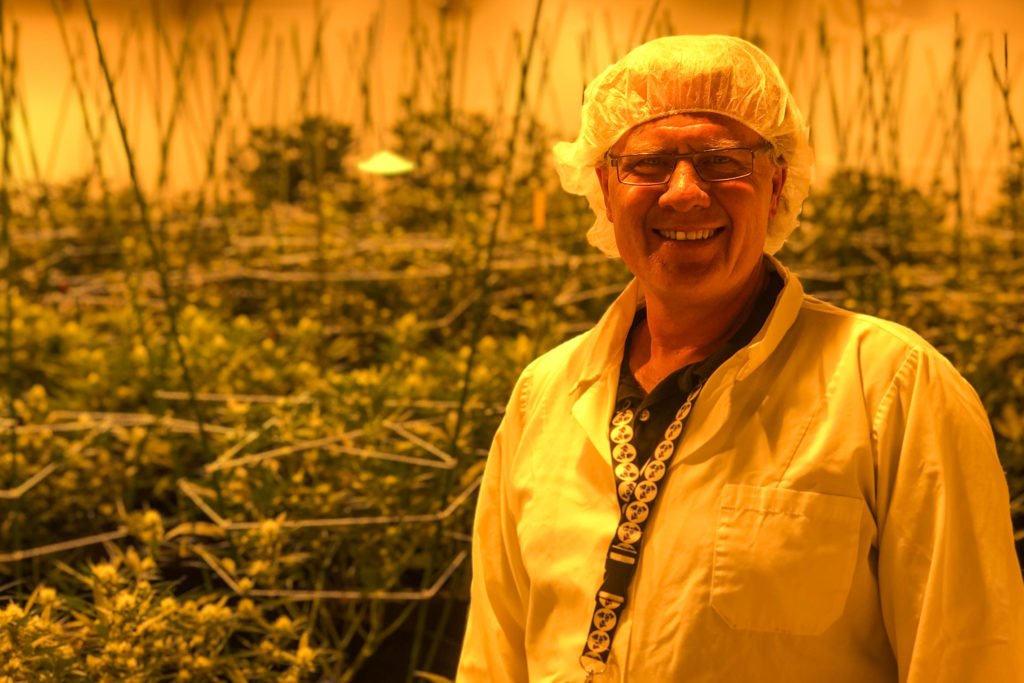Growing Cannabis Could Lead To More Air Pollution
4:47 minutes

 This segment is part of The State of Science, a series featuring science stories from public radio stations across the United States. This story, by Michael Elizabeth Sakas, originally appeared on Colorado Public Radio.
This segment is part of The State of Science, a series featuring science stories from public radio stations across the United States. This story, by Michael Elizabeth Sakas, originally appeared on Colorado Public Radio.
Between water and electricity, Colorado’s legal cannabis industry already has a big environmental footprint. But what about Front Range air quality? Could the plant itself be contributing to air pollution?
No, it’s not the pot smoke. Colorado Department of Public Health and Environment is conducting a study of terpenes, the organic compounds that make the cannabis plant smell so strong.
Terpenes are classified as volatile organic compounds. Many consumer products release VOCs, like acetone in nail polish remover and butanal from barbecues and stoves. VOCs from terpenes are harmless until they combine with combustion gases to create ozone.
That’s why the state is studying marijuana emissions—it’s about where it’s grown. Unlike other VOC-emitting crops, like lavender, cannabis is often cultivated in greenhouses in the industrial areas of cities, near highways and lots of cars.
“Here in Colorado, as far as air quality concerns go, ozone is our largest pollutant of concern. We are not meeting the national ambient air quality standards for ozone,” said CDPHE’s lead researcher on this project, Kaitlin Urso.
Denver’s ozone problem is especially bad. According to the American Lung Association, it has the nation’s 12th worst air quality. Usually, it’s the Environmental Protection Agency that studies emissions from new industries. Since marijuana is still a federally controlled substance, it can’t.
With the feds on the sideline, Urso said it’s now up to the state to figure out, essentially, “how many pounds of VOCs are emitted into our atmosphere per pound of marijuana grown?”

Indoor and outdoor air samples were taken from four volunteer cannabis companies during different stages of cultivation, including processing. It’s that final stage where “you get a lot higher VOC emission rates.”
“They’re cutting [marijuana] all up, sending them through roto machines that are flinging plant material everywhere,” Urso said.
The state’s study will be the most robust of its kind and builds on the research of William Vizuete, an associate professor at the University of North Carolina Chapel Hill. His study found cannabis grows could contribute anywhere from 66 to 657 tons of emissions per year. Compared to the total VOCs found in the state, that’s about a half a percent to 3.5 percent increase.
Vizuete’s final findings are in the review process and haven’t been published yet, although he shared his results with CPR News in advance.
He acknowledges the range of VOCs is broad. He’s now working with CDPHE and Urso in hopes of narrowing how much gas is released by marijuana grows.
Vizuete’s work has helped identify what types of gases cannabis emits. He said he was surprised to find it “really varied by the strain.” The plant’s life cycle matters as well, “as it grew older and matured, the types of gases that it was releasing also changed,” Vizuete said.
With more than 600 strains of cannabis in Colorado, he said there could be a wide range and volume of gas emitted by these plants.
Research is hard without government support, so it’s up to “states with limited budgets and limited research to fill the role of what the federal government would do in determining the basic science and developing the tools that are needed to make decisions,” he said.
When Vizuete came to Colorado, he teamed up with the National Center for Atmospheric Research in Boulder. He thought that in a legal state his work would be in the clear. He then found out he wasn’t allowed to grow pot in federally-supported research labs, so he had to improvise.
“We grew them in a garage. We set up some grow lights. We had to choose several strains of marijuana. And we had friends that helped out, to water and take care of the plants,” he said.

Vizuete’s research was done without any big federal money, which he argues is needed to better understand the cannabis industry’s health impacts. He might work with Canada, who’s expressed interest in his research now that the country has legalized marijuana.
Without federal guidance, it’s also up to states to set emission standards on the cannabis industry. In Colorado, there aren’t any.
Even if the state’s study does expose a pollution problem, state law says regulators can’t do anything about it. Of course, lawmakers could always step in. That’s why Scott Brady, the grow operations manager at Smokey’s 420 dispensary, was at first hesitant to participate in Colorado’s study. For him, anytime cannabis opens itself up to scrutiny, it’s unclear where it could lead.
“But it’s important to know, either way, good news or bad news, what is it that we’re doing? And then, to be able to have conversations with them about what we can do to help that?” Brady said.
The state notes that carbon filters, which lots of grows already use to control smell, also do a great job of absorbing VOCs. Researchers hope to share more solutions like this and educate the cannabis industry about their possible environmental impact. Brady said he’s listening.
Smokey’s grow operation is in the small town of Garden City, which is less than one square mile across and tucked right up in the southeast corner of Greeley. During prohibition, this was the “wet” town while Greeley was “dry.” Fitting to its name, there are three cannabis grow houses within Garden City limits.
Smokey’s tries to be an environmentally-friendly business. Their goal is zero waste, sustainable packaging and what Brady calls “living soil”—worms and bugs, and lots of other organic matter, to grow their plants. That’s why Smokey’s volunteered to be part of the state study.
“We have an obligation to make sure that we are in addition to our communities, and not a drag on our communities,” Brady said.
The results of the CDPHE study are expected to be released in 2020.
Michael Elizabeth Sakas is a climate/environment reporter for Colorado Public Radio. You can learn more about CPR’s climate coverage by signing up for their newsletter.
SPEAKER 1: Now it’s time to check in on the state of science. This is APR, WWNO, Saint Louis Public Radio. Iowa Public Radio News.
IRA FLATOW: Local science stories of national significance. Marijuana is a big business, especially in Colorado. Since cannabis was legalized years ago, seven years ago, the state has dealt with a lot of unexpected pot related problems. There’s the environmental toll that comes from the large amounts of electricity, and water needed to cultivate the plants
And now, a new concern about how cannabis cultivation might impact air quality. My next guest is here to clear the air, and tell us more about cannabis and air pollution. Michael Sazeck, is a climate and environment reporter at Colorado Public Radio. Welcome, Michael.
MICHAEL ELIZABETH SAKAS: Hi Aaron, thanks for having me on.
IRA FLATOW: You’re welcome. OK. In your story, you talked to some researchers from Colorado Department of Public Health and Environment, who are concerned about cannabis and air pollution. What was their main concern?
MICHAEL ELIZABETH SAKAS: Yes so this, they’re actually looking at how the plant itself might be contributing to ozone. So this isn’t about smoking the plant. This isn’t about that water and the electricity that these grow houses uses. This is actually about terpenes, which is an organic compound that’s classified as a volatile organic compound, and how those gases might actually mix with combustion emissions, which come from cars, to mix and create ozone.
IRA FLATOW: Oh, so this is that kind of air pollution problem. Interesting.
MICHAEL ELIZABETH SAKAS: Yes, and it’s a big issue in Denver, yes.
IRA FLATOW: And cannabis isn’t the only plant that releases terpenes, right?
MICHAEL ELIZABETH SAKAS: Yeah, so any– think of plants that you can, might have strong smells. So like lavender, or pine trees. They can produce terpenes. And these terpenes are actually harmless all by themselves. But what the concern is that when these terpenes, which, again, are classified as volatile organic compounds, when those VOCs mix with combustion emissions, it can create ozone. And in the presence of sunlight, that’s the, kind of the perfect equation for ozone.
IRA FLATOW: So are they concerned then about it in big cities like Denver, or places like that, or generally all around the state?
MICHAEL ELIZABETH SAKAS: So, it’s, Denver is definitely the biggest issue in Colorado. But ozone can spread. But it really, it’s where the, so in Colorado, and in Denver, that’s where a lot of our marijuana and cannabis grow houses are. There are over 300 within the city itself.
And they’re usually industrial areas where they are in warehouses. So they’re by highways, and lots of cars. And so that’s really where the concern is, that mixture of these types of gases, all right here in the city of Denver. And it can be big issues for cities across the country, that are legalizing cannabis, and might be experiencing that same issue.
IRA FLATOW: Now I know that you’ve also talked to a researcher at the University of North Carolina in Chapel Hill, who has done some work around air pollution and cannabis. What has he found so far?
MICHAEL ELIZABETH SAKAS: Yes, so some of his research has come out. Some is still waiting to come out. He shared some of his findings with us early. And he found that VOCs, tons of emissions per year, could be 66 to 657 tons of VOC emissions per year coming from these grows in Colorado. And he acknowledges that is a very broad number, and that the research through the Colorado Department of Public Health and Environment and other research will help narrow that number down, so we can really decide exactly how much tons of emissions are coming from these marijuana grows.
IRA FLATOW: And one of the interesting sidebars to this story is that he had to grow it in his garage, right? Because cannabis growing is not legal federally, right?
MICHAEL ELIZABETH SAKAS: Yeah. So he came to Colorado to do his research, because it’s not legal in North Carolina. And he thought that once he got here, that his research would be in the clear. But he actually teamed up with the National Center for Atmospheric Research, and their labs are federally funded. So when he came to Colorado, and he planned on growing those plants in their labs, he found out he couldn’t do that. So he had to improvise, and he grew them in a garage in Boulder. And he grew a couple different strains and tested the air quality kind of throughout their lifecycle. And he found that different types of VOCs in different amounts would be released, depending on the type of strain of marijuana, cannabis, and at which phase of its life it was in.
IRA FLATOW: Terrific. Thank you, Michael Elizabeth Sakas, a climate environmental reporter for Colorado Public Radio. Thank you for joining us today.
MICHAEL ELIZABETH SAKAS: Yes, thanks for having me on. I really appreciate it.
Copyright © 2019 Science Friday Initiative. All rights reserved. Science Friday transcripts are produced on a tight deadline by 3Play Media. Fidelity to the original aired/published audio or video file might vary, and text might be updated or amended in the future. For the authoritative record of Science Friday’s programming, please visit the original aired/published recording. For terms of use and more information, visit our policies pages at http://www.sciencefriday.com/about/policies/
Danya AbdelHameid is Science Friday’s fall 2019 narrative podcasting intern. She’s most interested in telling stories about the complex, messy ways that science interacts with culture, history, and society, but she’s really into glaciers and ice sheets, too.
Ira Flatow is the founder and host of Science Friday. His green thumb has revived many an office plant at death’s door.